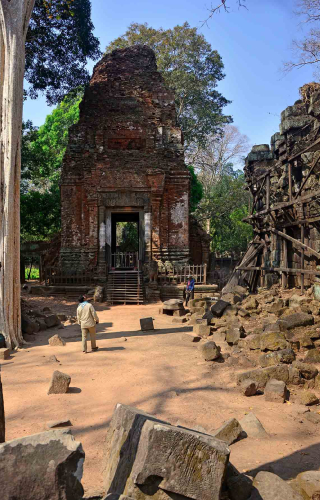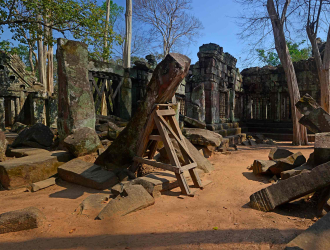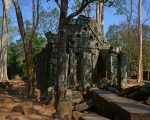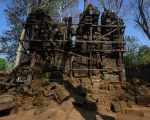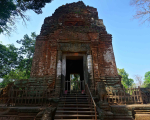Angkor–right from its foundation in 802 CE—was based on devotion to Lord Shiva and veneration of the sacred phallus, the lingam. Jayavarman II, founder of Angkor, consecrated himself king on top of Mahendraparvata, announcing his lordship over the country and sovereignty of Cambodia. To conduct this ceremony, he invited a Brahman named Hiranyadama, who sanctified a royal lingam symbolising the temporal authority of Jayavarman II as Chakravartin (universal monarch). After his death, Jayavarman II was given the posthumous title Paramesvara (Supreme Lord), one of the many manifestations of Lord Shiva. Over the next century, every new ruler on the occasion of his rajyabhiseka would consecrate the royal lingam, thus establishing his divine authority, and taking on the responsibilities of kingship as the Devaraja (God-King). The royal lingam was ceremonially installed in a mountain-temple, which formed the nucleus of an urban settlement. During the period of Harshavarman I (r. 910–923) and his successor Ishanavaraman II (r. 923–928), Angkor was ruled from the twin cities Yashodharapura and Hariharalaya. However, mere installation of a lingam with magical powers neither ensured peace and stability nor longevity of the ruler. Rulers had to be eternally vigilant and be ready to thwart rivals and quell rebellions.
In 921 CE, an inscription describes the establishment of a rival power at a remote location, 127 km northeast of Yashodharapura. This challenger, Jayavarman IV, was a maternal uncle to Ishanavarman II. Jayavarman IV named his seat of power Chok Gargyar and on December 12, 921 CE, conducted a grand consecration ceremony of the royal lingam as Tribhuvaneshwara. This specially chosen manifestation of Lord Shiva as the Supreme Lord of Three Realms, i.e. swarga (heaven), prithvi (earth) and patala (netherworld), was an appropriate metaphor for the new king’s ambitions. Chok Gargyor was located roughly midway on a highway connecting Yashodharapura to Preah Vihear. From Preah Vihear, the road split in two directions: one went towards Phimai in Thailand, and the other to Wat Phu in Laos; both crucial outposts of the empire. This gave Jayavarman IV strategic edge, allowing him to boss over Angkor. In 928 CE, Isanavarman II’s chaotic reign ended, and Jayavarman IV’s moment of glory arrived. He crowned himself Chakravartin.
Now that he controlled the vast resources of Angkor, Jayavarman IV set about commissioning grand construction projects to encourage new settlers and establish his writ as absolute monarch. He immediately shifted the seat of power to Chok Gargyar, and set out planning a new city worthy of its status as capital of the most powerful empire in Southeast Asia. Jayavarman IV was acutely aware of Chok Gargyar’s Achilles’ heel, its disadvantageous location in a hot, dry region with few natural water resources. To address this problem, the largest project undertaken at Chok Gargyar was the construction of a vast baray (water harvesting tank), called the Rahal. Measuring 1185 m x 548 m, the Rahal met the daily water requirements of a large population and helped in irrigation of agricultural fields.
Jayavarman IV further executed his imperial vision through the temple-mountain he commissioned, which surpassed all previous temple-mountains in scale and size. Prasat Prang —as the pyramidal structure is now called— rose to a height of 120 feet and was crowned by the Tribhuvaneshwara Linga, which, according to French archaeologist Henri Parmentier, stood 14-feet tall. This was the largest lingam ever made in Angkor, and lifting it to the top of the pyramid was a monumental feat of engineering and manpower, recorded in inscriptions with great joy and relief on its successful installation.
Jayavarman IV’s intent to scale up things was also evident in statues produced during this period. A dancing Shiva (Nataraja) installed in Prasat Kraham was 4 meters tall! A giant statue of Garuda —two metres tall— was recovered from the site, which now welcome visitors at the National Museum at Phnom Penh. Monolithic lingams were carved in the bedrock, meaning they were not installed by any person but existed naturally. These in situ lingams are similar in concept to the 12 sacred Jyotirlingams of India, which are also swayambhu (self-manifested). Ornamental pediments make their debut at temple entrances and sculptures anticipate dynamism and fluidity, qualities which reach their apogee in the later artwork of Banteay Srei.
Jayavarman IV ruled only for 13 years, not enough time to fully realise his ideas. He was given the posthumous title Paramasivapada (Devoted servant at the feet of Shiva), further emphasising his loyalty to Lord Shiva. During his period, many Shiva temples were built at Chok Gargyar, however, nothing was added by his son and successor Harshavarman II. In 944 CE, when Rajendravarman I became the new king, he restored the capital to Yashodharapura, bringing an end to Chok Gargyor’s 16-year period as capital of Angkor.
Without patronage and facing debilitating factors, Chok Gargyor’s construction boom went bust. As feared by Jayavarman IV, the Rahal dried up. The last recorded building added during the period of Jayavarman VII, in beginning of the thirteenth century, was one of his 102 hospital-chapels. By the fourteenth century, when Buddhism established itself as the new official religion of Angkor, the site was abandoned. Since no Buddhist structures were added, Chok Gargyor remained a Hindu site, dedicated exclusively to Lord Shiva. In the nineteenth century, French explorers rediscovered the site and the old name was revived in a new avatar—Koh Ker.
Covered by thick forests and left unguarded, wanton destruction was unleashed on Koh Ker. Cambodia in the nineteenth century was a shadow of its glorious past and was relegated to a rump state dependant on protection by the French. The French colonialists, taking full advantage of a weak and poor country, plundered Angkor sites, digging up monuments hoping to find hidden treasure. Precious artworks were smuggled out to fill museums in France, like the Guimet Museum in Paris that has in its collection a statue of Jayavarman IV paying homage to Yama—the Hindu God of Death—taken from Koh Ker.
In the 1970s, Cambodia plunged into a civil war unleashed by the ultra-left Khmer Rouge regime. After the war ended, Koh Ker was painstakingly de-mined and more than 180 monuments identified. In comparison to temples at Angkor, little restoration has happened at Koh Ker. Many ruined monuments are on the verge of collapse; some are supported by wooden frames while others are tied up with wire. Although the site has been pillaged of all standing artwork, it continues to be targeted by gangs of thieves.
Koh Ker needs better protection and conservation. Since 1992, it has been on the UNESCO tentative world heritage list, but has not been recognised yet. During its short period as capital of Angkor, Koh Ker ushered in a golden age of Hindu culture in Cambodia and laid the foundation of a renaissance which followed in the immediate period. The site fully deserves the UNESCO World Heritage Site status, which it should hopefully get in the near future.
Bibliography:
"The Indianized States of South East Asia" by George Coedes, Edited by Walter F. Vella, Translated by Susan Browning Cowing
"Images of the Gods: Khmer mythology in Cambodia, Thailand and Laos" by Vittorio Roveda
"Focusing on the Angkor Temples: The guidebook" by Michel Petrotchenko
